The Hukbalahap movement emerged as a defining force in Philippine history during World War II. Formed in 1942, it began as a response to the Japanese invasion and quickly evolved into a powerful guerrilla force. The group, often referred to as the “Huks,” played a crucial role in resisting the Japanese occupation and protecting local communities.
Rooted in the struggles of peasant farmers, the movement symbolized a fight for justice and survival. Its origins trace back to the hardships faced by rural populations during the Japanese occupation. The Huks not only defended their land but also laid the groundwork for future political and social changes in the Philippines.
This introduction explores the rise of the Hukbalahap, its impact during the war, and its lasting legacy. By understanding its beginnings, we gain insight into a pivotal chapter in the nation’s history.
Key Takeaways
- The Hukbalahap was formed in 1942 during World War II.
- It began as a resistance movement against the Japanese invasion.
- The group primarily consisted of peasant farmers.
- It played a significant role in defending local communities.
- The movement laid the foundation for future political changes.
Historical Roots and Socioeconomic Conditions in the Philippines
The seeds of rebellion in the Philippines were sown centuries before the Hukbalahap emerged. The country’s history is deeply intertwined with the struggles of its rural population, particularly tenant farmers. Understanding these roots is essential to grasp the broader context of agrarian unrest.
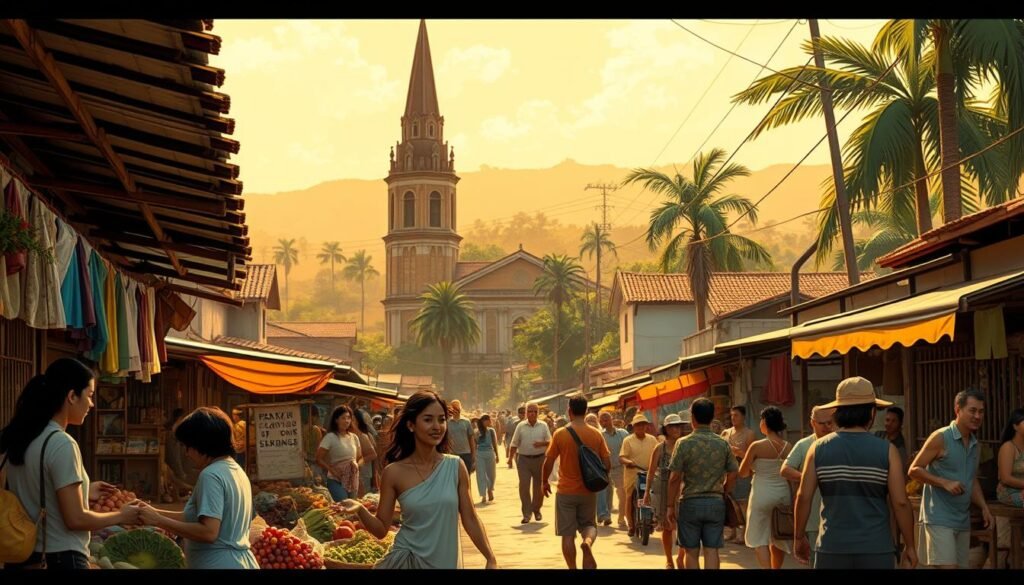
Impact of Spanish Encomienda and Landowner Exploitation
Spanish colonization introduced the encomienda system, which created lasting socioeconomic disparities. Under this system, large tracts of land were granted to Spanish settlers, leaving peasant farmers with little to no control over their livelihoods. This exploitation continued even after Spanish rule ended, as local landowners perpetuated the cycle of inequality.
During this period, rural communities faced harsh conditions. Tenant farmers were often forced to pay exorbitant rents, leaving them in perpetual poverty. The lack of land ownership and fair treatment fueled discontent among the peasant class, setting the stage for future resistance movements.
Peasant Struggles and Early Agrarian Unrest
The Philippines saw the gradual rise of political consciousness among its rural population. Tenant farmers began organizing to demand better conditions and fair treatment. These early efforts laid the groundwork for more structured movements, including the Hukbalahap.
The connection between land exploitation and peasant resistance became increasingly evident. As rural communities united, their struggles highlighted the need for systemic change. This history of resilience and determination remains a defining aspect of the Philippine identity.
Emergence and Formation of the Hukbalahap
Amid the chaos of World War II, a powerful resistance movement took shape in the Philippines. The Japanese occupation of the islands created a dire need for organized defense. Local communities, especially in Central Luzon, faced immense hardship under foreign rule. This period marked the birth of a guerrilla force that would become a symbol of resilience and unity.
Organizational Beginnings During Japanese Occupation
The movement began as a response to Japanese military aggression. Peasant farmers, who had long suffered under exploitative systems, became the backbone of the resistance. Local leaders stepped forward to organize these fighters into a cohesive unit. Their goal was clear: protect their communities and reclaim their land.
Recruitment efforts focused on rural areas, where the impact of the occupation was most severe. These early steps laid the foundation for a new kind of resistance. The movement’s structure was designed to operate in secrecy, relying on unconventional tactics to outmaneuver the enemy.
Formation of a United Front Resistance
As the movement grew, it evolved into a united front. Diverse groups, including peasant organizations and political activists, joined forces. This unity was crucial in amplifying their impact. Together, they formed a formidable resistance against a common enemy.
The term “guerrilla” perfectly described their approach. They relied on surprise attacks, ambushes, and hit-and-run tactics. These methods allowed them to challenge a better-equipped and larger force. By late 1943, the movement had grown to include thousands of fighters, both active and in reserve.
This united front not only resisted the Japanese but also laid the groundwork for future political and social changes. Their efforts during this turbulent time remain a testament to the power of collective action.
Guerrilla Warfare Tactics and Key Battles
Guerrilla warfare became a defining strategy during the Japanese occupation of the Philippines. The resistance relied on unconventional tactics to outmaneuver a better-equipped enemy. These methods included ambushes, sabotage, and hit-and-run operations. The goal was to disrupt Japanese forces while minimizing losses.
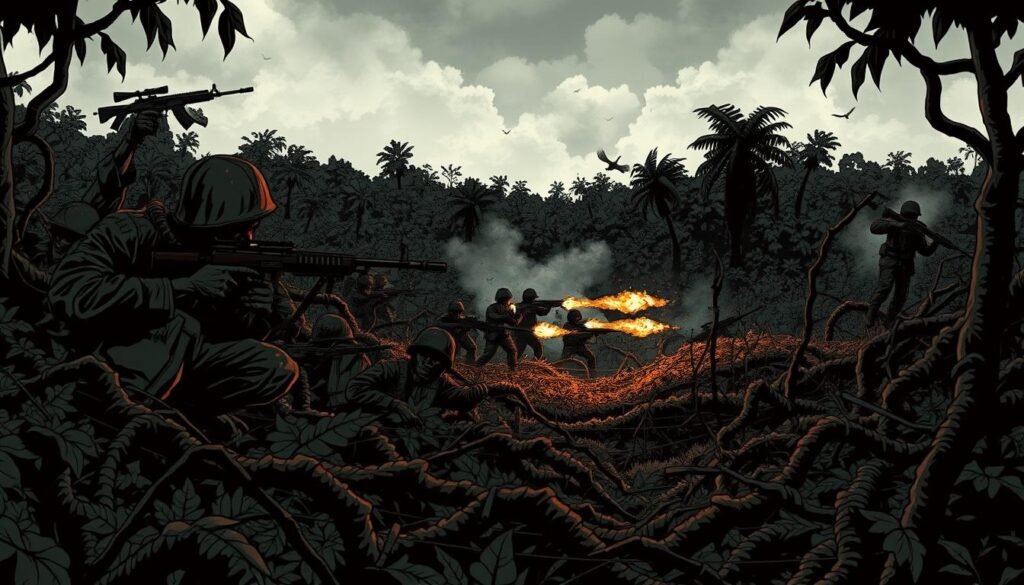
Successful Raids and Engagements Against the Japanese
One of the most effective tactics was the use of surprise attacks. Guerrilla fighters targeted supply lines, communication hubs, and isolated enemy units. These raids weakened Japanese control and boosted morale among local communities. For example, a coordinated attack on a Japanese outpost in Central Luzon showcased the fighters’ ability to strike swiftly and disappear.
Another key strategy was the integration of local knowledge. Fighters used the terrain to their advantage, setting traps and ambushes in dense forests and mountainous regions. This approach allowed them to engage in direct fights without exposing themselves to overwhelming enemy force.
Military Strategies That Shaped the Resistance
The resistance adopted a decentralized command structure. This allowed units to operate independently while staying connected to the broader movement. Leaders emphasized the importance of mobility and adaptability. These principles were crucial in maintaining the warfare effort over time.
Coordination between units was another critical factor. Fighters relied on runners and radio communication to share intelligence and plan operations. This network enabled them to launch synchronized attacks across multiple fronts. The result was a sustained campaign that kept Japanese forces on the defensive.
Key battles, such as the liberation of small towns, demonstrated the effectiveness of these strategies. These victories not only weakened the enemy but also inspired more Filipinos to join the resistance. The legacy of these tactics continues to influence modern military thinking.
The Role of Filipino Women in the Movement
Filipino women stepped into critical roles during the resistance, reshaping traditional expectations and proving their strength in wartime. They were not just bystanders but active participants in the fight for freedom. Their contributions spanned from direct combat to essential support roles, ensuring the movement’s success.
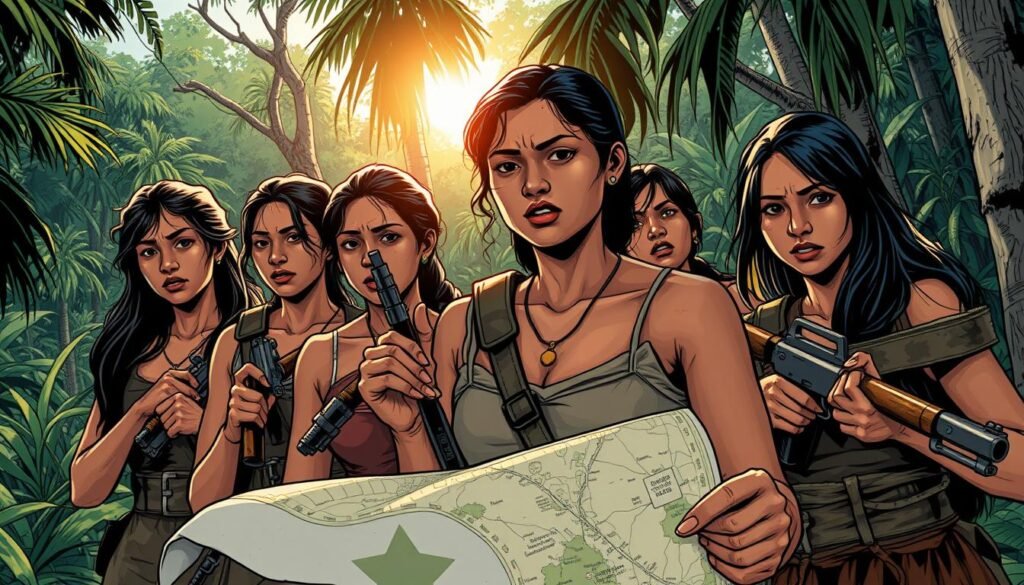
Women in Combat and Support Roles
Many women took up arms, joining the fight on the front lines. Figures like Felipa Culala, a guerrilla commander, led successful ambushes that inflicted heavy losses on enemy forces. These women fighters, often called Huk Amazons, became symbols of courage and resilience.
Beyond combat, women played vital roles in logistics and intelligence. They gathered critical information, transported supplies, and provided medical care to wounded fighters. Their efforts ensured the movement remained operational even under intense pressure.
In their home communities, women became pillars of support. They organized food drives, sheltered fighters, and maintained morale. Their ability to blend traditional roles with wartime needs was crucial to the resistance’s survival.
Leadership and Innovation in Wartime
Women also emerged as leaders, guiding units and making strategic decisions. They took on roles in healthcare, communication, and even propaganda, using their skills to strengthen the movement. Their visibility in these positions challenged societal norms and inspired future generations.
- Women led successful ambushes, proving their combat prowess.
- They provided essential support, from medical care to intelligence gathering.
- Their leadership in healthcare and communication was groundbreaking.
- They maintained morale and organized resources in their communities.
The blend of traditional and wartime roles showcased the adaptability of Filipino women. Their contributions were not just vital to the resistance but also a testament to their enduring strength and resilience.
Core Leadership and Influential Figures of the Hukbalahap
Leadership played a pivotal role in shaping the resistance movement during the Japanese occupation. At its helm was Luis Taruc, a charismatic and strategic leader who became the supreme commander. His vision and determination inspired thousands to join the fight for freedom.
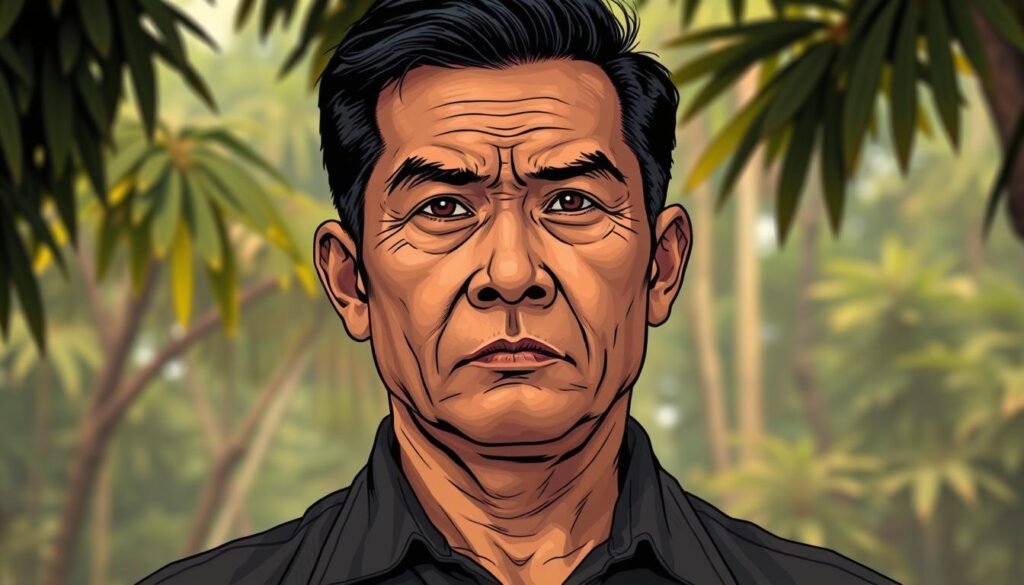
Luis Taruc: The Supreme Commander
Luis Taruc was born in 1913 in San Luis, Pampanga. From a young age, he witnessed the struggles of tenant farmers, which fueled his passion for social justice. By 1942, he emerged as a key figure in the resistance, uniting peasant farmers and guerrilla fighters under a common cause.
Taruc’s leadership was marked by his ability to adapt to changing circumstances. He implemented innovative strategies, such as decentralized command structures, which allowed units to operate independently while maintaining cohesion. His focus on the east regions of Central Luzon proved crucial in securing key victories against Japanese forces.
One of his most notable achievements was the successful liberation of several towns, which boosted morale and demonstrated the effectiveness of guerrilla tactics. Taruc’s personal charisma and tactical genius earned him the respect of his peers and the loyalty of his followers.
Other Key Leaders and Strategists
While Luis Taruc was the face of the movement, other leaders played vital roles in its success. Regional commanders, particularly in the east, implemented strategies tailored to their local environments. These leaders ensured that the resistance remained adaptable and resilient.
For example, Casto Alejandrino, a close ally of Taruc, focused on organizing supply lines and intelligence networks. His efforts were instrumental in sustaining the movement during prolonged conflicts. Similarly, female leaders like Felipa Culala broke barriers by leading combat units and providing essential support.
The collaboration between these leaders created a dynamic and effective resistance. Their ability to inspire and mobilize communities was a testament to their dedication and vision.
| Leader | Role | Contribution |
|---|---|---|
| Luis Taruc | Supreme Commander | Strategic planning and leadership |
| Casto Alejandrino | Regional Commander | Supply and intelligence coordination |
| Felipa Culala | Combat Leader | Frontline operations and morale building |
The leadership dynamics of the movement were a key factor in its success. Luis Taruc and his colleagues not only fought for immediate liberation but also laid the groundwork for future social and political reforms. Their legacy continues to inspire generations in the Philippines.
United Front: Connecting with Broader Guerrilla Groups and the Philippine Commonwealth
Building a united front was essential for the resistance to thrive during the Japanese occupation. The movement’s success relied on collaboration with local and allied forces, as well as the support of communities across the Philippines. This section explores how diverse groups came together to form a cohesive resistance network.
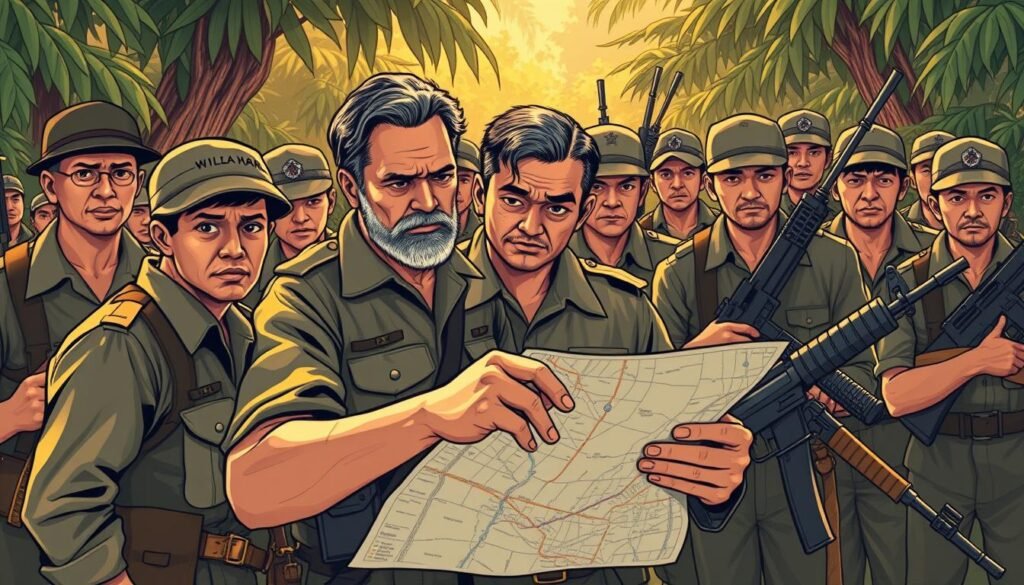
Collaboration with Local and Allied Forces
The resistance movement was not isolated. It actively sought partnerships with other guerrilla groups and the Philippine Commonwealth. These alliances provided crucial resources, intelligence, and manpower. For example, the movement collaborated with local leaders in Central Luzon to coordinate attacks and share supplies.
External support from political allies also played a significant role. Leaders worked to secure backing from the Philippine Commonwealth, which was instrumental in legitimizing their efforts. This collaboration ensured that the resistance had access to broader networks and strategic guidance.
Historical documents reveal that aligning varied guerrilla factions required significant cooperation at both the local and state levels. This unity allowed the movement to amplify its impact and sustain its operations over time.
Challenges in Coordinating a Diverse Resistance
Creating a united front was not without difficulties. The resistance comprised diverse groups with different goals and strategies. Synchronizing these efforts required careful planning and compromise. Leaders had to navigate cultural and regional differences to build trust and cooperation.
One major challenge was the lack of centralized communication. Units often operated independently, making it difficult to coordinate large-scale operations. Despite these obstacles, the movement’s leaders emphasized the importance of unity. They believed that a cohesive front was essential for achieving their shared goals.
The role of local communities was also critical. Their support provided the movement with essential resources and safe havens. This grassroots backing was a testament to the widespread desire for liberation and justice.
“Unity is strength. When there is teamwork and collaboration, wonderful things can be achieved.”
| Group | Contribution |
|---|---|
| Local Guerrillas | Provided manpower and local knowledge |
| Philippine Commonwealth | Offered strategic guidance and legitimacy |
| Communities | Supplied resources and safe havens |
The resistance’s ability to form a united front was a key factor in its success. By overcoming challenges and leveraging external support, the movement demonstrated the power of collective action. This unity not only strengthened their fight against the Japanese but also laid the groundwork for future political and social reforms.
For more insights into the role of local leaders in the resistance, visit this detailed analysis.
U.S. Involvement and Military Assistance Strategies
American military intervention significantly altered the dynamics of the Philippine insurgency. The United States provided critical support to the local government, shaping the course of the conflict. This assistance included advanced weaponry, training, and strategic guidance, which proved instrumental in countering guerrilla operations.
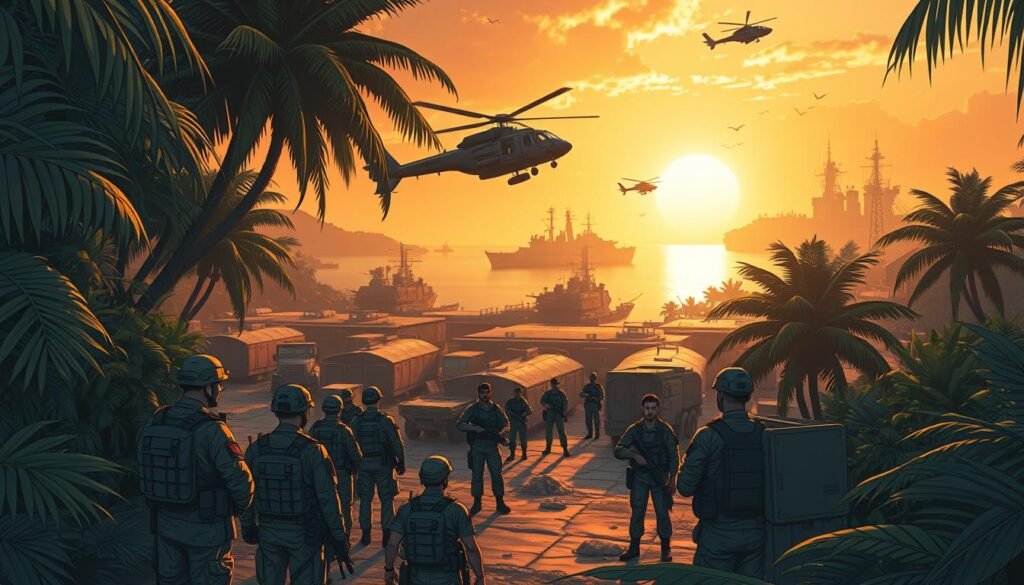
The collaboration between states army forces and Philippine troops marked a turning point. American advisors worked closely with local leaders to implement effective counterinsurgency strategies. This partnership strengthened the government‘s ability to respond to the insurgency.
Impact of American Weaponry and Advisory Support
The introduction of advanced army equipment transformed the battlefield. U.S.-supplied weapons enhanced the combat capabilities of Philippine forces, giving them a significant advantage. This shift in firepower disrupted guerrilla operations and reduced their effectiveness.
Strategic policy decisions, guided by American advisors, also played a crucial role. These policies focused on improving coordination and intelligence-sharing between forces. The result was a more unified and efficient counterinsurgency effort.
For a deeper understanding of how U.S. involvement influenced the conflict, explore this detailed analysis.
Transition from Resistance to Rebellion
After World War II, the movement shifted from covert operations to open rebellion, driven by unresolved grievances and government actions. The end of the war did not bring peace to the Philippines. Instead, it marked the beginning of a new struggle, as peasant farmers faced continued exploitation and broken promises.
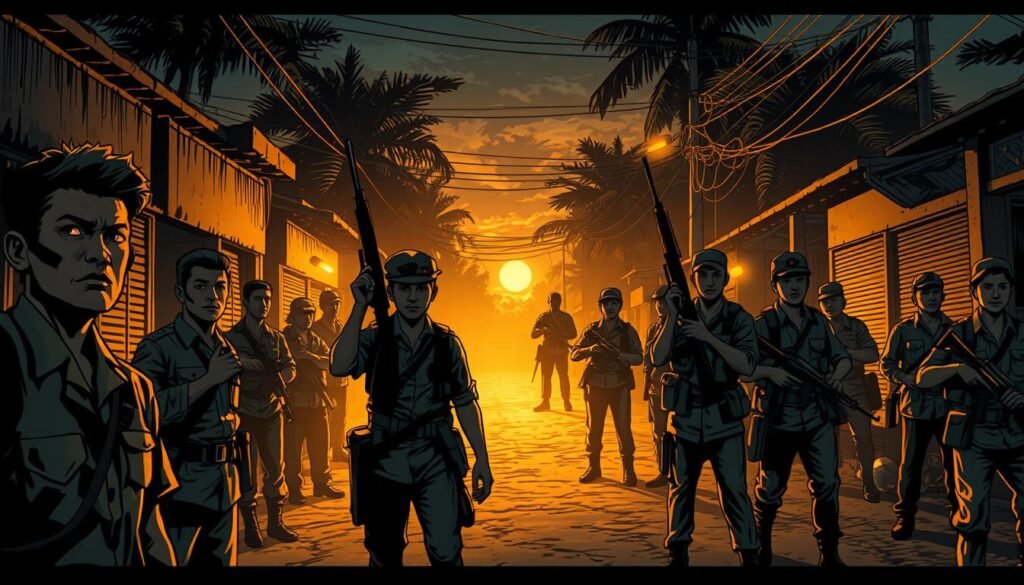
Factors Leading to the Shift from Guerrilla Warfare
The transition from organized resistance to full-scale rebellion was fueled by several factors. Peasant farmers, who had fought bravely during the war, expected land reforms and fair treatment. However, the government failed to address their demands, leading to widespread discontent.
Broken promises and continued exploitation deepened rural unrest. Many farmers felt betrayed, as their sacrifices during the war were ignored. This sense of injustice pushed them to abandon covert tactics and take up arms openly.
Escalation of Post-WWII Conflict
Government policies played a significant role in intensifying rural discontent. Instead of addressing the root causes of peasant grievances, the government focused on suppressing dissent. This approach only fueled the rebellion, as more people joined the cause.
The prolonged resistance during the war had already laid the groundwork for rebellion. The shift from guerrilla tactics to open conflict was a natural progression, driven by the need for systemic change. Immediate causes, such as government crackdowns and the lack of reforms, accelerated this transition.
“The rebellion was not just a fight for land; it was a fight for dignity and justice.”
For a deeper understanding of this pivotal period, explore the Hukbalahap Rebellion on Britannica.
Communist Ideology and the Hukbalahap
Communist principles became a driving force behind the rebellion’s strategic direction. The movement adopted Marxist-Leninist ideas to justify its struggle and frame its actions within a broader ideological contest. This shift marked a significant turning point, as the rebellion evolved from a local resistance to a politically charged movement.
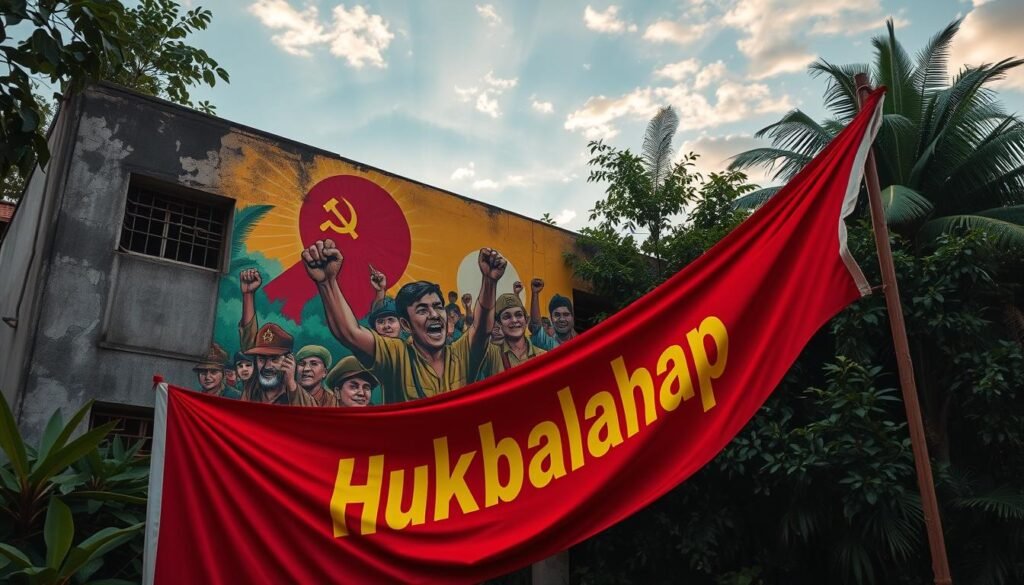
Marxist-Leninist Influences on the Movement
The introduction of communist ideology provided a framework for the rebellion’s goals. Leaders used Marxist-Leninist theory to analyze the socioeconomic conditions of rural communities. This analysis informed their strategic decisions, emphasizing the need for systemic change and land reforms.
Internal debates often centered on balancing ideological purity with practical demands. Some leaders argued for strict adherence to communist principles, while others prioritized immediate needs. These discussions shaped the movement’s direction and highlighted the challenges of aligning theory with action.
- Marxist-Leninist theory guided long-term goals, such as land redistribution.
- Ideological debates influenced the movement’s organizational structure.
- The rebellion’s increasing politicization attracted broader support.
Connection Between Military Actions and Ideology
The movement’s military actions were deeply tied to its communist ideology. Guerrilla tactics were not just about defeating the enemy but also about advancing social justice. Leaders framed their operations as part of a larger struggle against exploitation and inequality.
For example, raids on landowner properties were justified as acts of retribution for years of oppression. This connection between ideology and action resonated with many rural communities, who saw the rebellion as a fight for their dignity and rights.
| Aspect | Influence |
|---|---|
| Strategic Planning | Guided by Marxist-Leninist analysis |
| Military Operations | Linked to ideological goals |
| Community Support | Strengthened by shared ideals |
The rebellion’s communist underpinnings also drew inspiration from earlier socialist movements in the Philippines. For a deeper understanding of these influences, explore the history of radical leftist movements in the region.
“The struggle was not just against an enemy but for a vision of justice and equality.”
By integrating communist ideology into its core, the movement transformed into a powerful force for change. Its legacy continues to inspire discussions about social justice and reform in the Philippines.
Land Reforms and Peasant Unrest in Central Luzon
Central Luzon, known as the rice granary of the Philippines, became a hotbed of peasant unrest in the post-war era. The region’s fertile lands, crucial for rice production, were at the center of a fierce struggle for land reform. Disputes over food distribution and ownership rights fueled widespread discontent among tenant farmers.
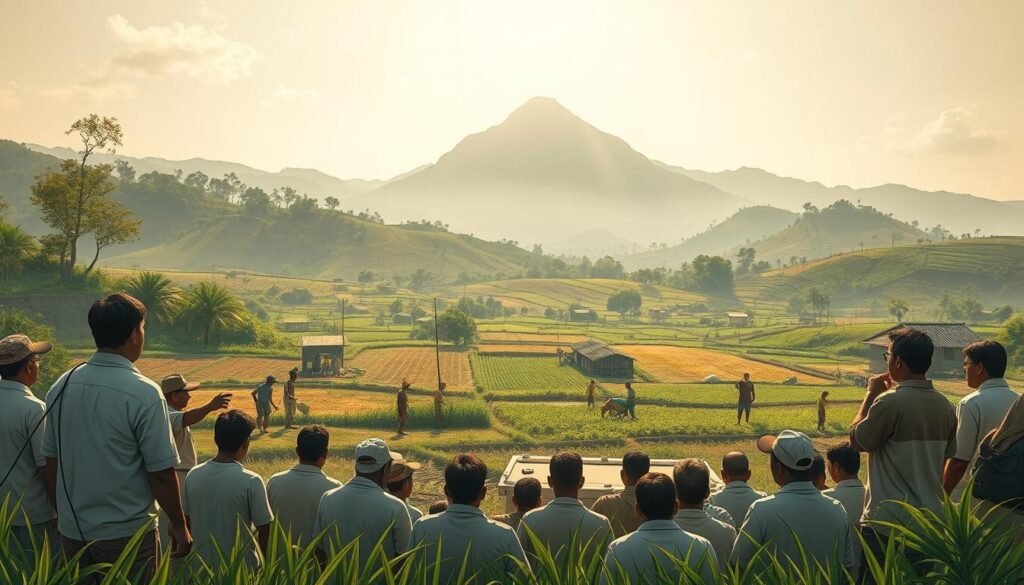
Socioeconomic Disparities Fueling the Rebellion
The agricultural landscape of Central Luzon was marked by stark inequalities. Wealthy landowners controlled vast estates, while tenant farmers struggled to make ends meet. The scarcity of rice and other staple food items exacerbated the hardships faced by rural communities.
Land ownership issues were a major source of tension. Many farmers worked tirelessly on land they did not own, receiving only a small share of the harvest. This system perpetuated poverty and deepened the divide between the rich and the poor in Luzon.
Government responses to agrarian demands were often inadequate. Promises of land reform were made but rarely fulfilled. This lack of action pushed many peasants to join the rebellion, seeking justice and a fairer distribution of resources.
Rebel groups, on the other hand, capitalized on this discontent. They framed their struggle as a fight for the rights of the oppressed, gaining support from rural communities. The economic motivations behind the rebellion were clear: peasants wanted control over the land they worked and a fair share of the food they produced.
“The struggle for land reform was not just about ownership; it was about dignity and survival.”
For more on the historical context of peasant unrest in Central Luzon, visit this detailed analysis.
Pivotal Moments and Turning Points in the Rebellion
Key events and strategic decisions shaped the trajectory of the rebellion, marking its most critical phases. From decisive military operations to the capture of influential leaders, these moments defined the movement’s legacy. Understanding these turning points provides insight into the rebellion’s successes and challenges.
Notable Military Operations and Raids
One of the most significant operations occurred in March 1949, when rebel forces launched a coordinated attack on a government outpost. This day marked a turning point, showcasing their ability to execute large-scale raids. The success of this operation boosted morale and demonstrated their growing strength.
Another critical event took place in the same year, when rebels targeted supply lines in Central Luzon. This strategic move disrupted government resources and weakened their hold on the region. These operations highlighted the rebels’ adaptability and determination.
The Capture of Luis Taruc and Its Impact
In May 1954, the capture of Luis Taruc dealt a severe blow to the rebellion. As the movement’s supreme commander, his arrest shifted momentum in favor of the government. This event marked the beginning of the rebellion’s decline.
The immediate aftermath saw a loss of coordination among rebel units. Without Taruc’s leadership, the movement struggled to maintain its strategic direction. This turning point underscored the importance of strong leadership in sustaining a rebellion.
“The capture of Taruc was not just a loss of a leader; it was a loss of hope for many who believed in the cause.”
For a deeper understanding of the rebellion’s strategic shifts, explore this detailed analysis.
The End Game: Defeat and Transformation of the Movement
By the early 1950s, the once-formidable resistance movement faced a dramatic decline, marked by mass surrenders and brutal confrontations. Sustained military pressure and strategic offensives led to the eventual end of large-scale operations. This section explores the factors behind the decline, the role of key events, and the transformation of former insurgents into political actors.
Military Offensives and the Decline of Active Resistance
Government forces launched a series of aggressive campaigns to dismantle the resistance. These operations targeted key strongholds, disrupting supply lines and communication networks. The relentless pressure forced many fighters to surrender, signaling the end of organized resistance.
One of the most significant turning points was the capture of key leaders. Without their guidance, the movement struggled to maintain cohesion. This loss of leadership further accelerated the decline.
Brutal Massacres and Their Impact
Instances of brutal massacre marked a dark chapter in the conflict. These events not only weakened the resistance but also sowed fear among supporters. The government’s harsh tactics were effective in dismantling the movement but left a lasting scar on the region.
The massacre of civilians in certain areas became a turning point. It shifted public opinion and eroded the moral high ground the resistance once held. These events underscored the human cost of the conflict.
Transformation of Former Insurgents
After the end of active resistance, many former fighters transitioned into political roles. They used their experience to advocate for social and economic reforms. This transformation marked a new chapter in their struggle for justice.
Some leaders became influential voices in local governance. Their efforts focused on addressing the root causes of the rebellion, such as land reform and economic inequality.
Social and Political Aftermath
The collapse of the resistance had far-reaching consequences. It prompted the government to reevaluate its policies, particularly in rural areas. The focus shifted toward addressing the grievances that had fueled the rebellion.
Land reform became a central issue, with the government implementing measures to redistribute land to tenant farmers. These changes aimed to prevent future unrest and promote stability.
| Aspect | Impact |
|---|---|
| Military Offensives | Led to mass surrenders and the decline of resistance |
| Massacres | Weakened morale and shifted public opinion |
| Transformation | Former insurgents became political advocates |
| Policy Changes | Focus on land reform and rural development |
The end of the movement marked a turning point in Philippine history. It highlighted the importance of addressing systemic issues to achieve lasting peace. The lessons learned continue to shape the nation’s approach to conflict and reform.
Conclusion
Historical records reveal that the rebellion left a profound mark on the Philippines, shaping its military and political landscape. From its origins as a response to oppression to its eventual decline, the movement highlighted the interplay of ideological, socioeconomic, and military factors. It became a transformative force, challenging existing systems and advocating for justice.
The lessons from this period remain relevant today. Guerrilla warfare, leadership dynamics, and state policy during the rebellion offer valuable insights into resistance and reform. Understanding this chapter of history helps us appreciate the struggles that shaped modern Filipino society.
For a deeper exploration of these themes, visit this detailed analysis. The legacy of this movement continues to inspire discussions on social justice and the enduring fight for equality.
FAQ
What were the main causes of the Hukbalahap Rebellion?
The rebellion was fueled by deep socioeconomic inequalities, landowner exploitation, and the impact of Japanese occupation. Peasant struggles and agrarian unrest in Central Luzon also played a significant role.
How did the Hukbalahap organize during the Japanese occupation?
The movement began as a united front resistance against Japanese forces. It combined guerrilla warfare tactics with local support to fight for Philippine independence.
What role did women play in the Hukbalahap movement?
Women were active in both combat and support roles, contributing significantly to the resistance effort. They helped with logistics, intelligence, and even fought on the front lines.
Who was Luis Taruc, and why was he important?
Luis Taruc was the Supreme Commander of the Hukbalahap. His leadership and strategic vision were crucial in shaping the movement’s direction and resistance efforts.
How did the U.S. support the Hukbalahap during World War II?
The U.S. provided military assistance, including weaponry and advisory support, to help the Hukbalahap fight against Japanese forces in the Philippines.
What led to the transition from resistance to rebellion after WWII?
Post-war socioeconomic disparities, unaddressed land reforms, and escalating tensions with the Philippine government transformed the movement into a full-scale rebellion.
What were the key military strategies used by the Hukbalahap?
The movement relied on guerrilla warfare tactics, including surprise raids and ambushes, to counter both Japanese and later Philippine government forces.
How did communist ideology influence the Hukbalahap?
Marxist-Leninist principles shaped the movement’s goals, emphasizing land reform, peasant rights, and a class struggle against exploitative landowners.
What were the major turning points in the rebellion?
Key moments included successful military operations, the capture of Luis Taruc, and the eventual decline of active resistance due to government countermeasures.
What happened to the Hukbalahap after the rebellion ended?
The movement gradually declined, with many members either surrendering or being captured. Its legacy, however, influenced later agrarian and communist movements in the Philippines.
Source Links
- What you need to know about the Hukbalahap | History | Phillife.co
- The Rise and Fall of the Hukbalahap Rebellion in the Philippines (1946-1954)
- History of the Philippines | People, Spain, United States, Revolution, Map, & Facts | Britannica
- Political history of the Philippines
- History of the Hukbalahap
- The Huk Rebellion in the Philippines: An Econometric Study
- Hukbalahap
- Guerrilla War on Luzon During World War II
- Guerrilla warfare – Insurgency, Tactics, Strategy | Britannica
- Hukbalahap rebellion
- Feminism and the womens’ movement in the Philippines : Struggles, advances, and challenges
- National Historical Commission of the Phillippines
- Guerrillas in the Philippines during World War II
- July 4, 1946: The Philippines Gained Independence from the United States | The National WWII Museum | New Orleans
- The Hukbalahap Movement
- The United States and the Philippine Hukbalahap Insurgency: 1946-1954
- Hukbalahap Rebellion | Filipino History, WWII Resistance | Britannica
- America’s Boy? The Philippines, 1947–1953 (Chapter 4) – The Forgotten Front
- The Hukbalahap
- Hukbalahap – The Philippines Free Press Online
- Benedict Anderson, Cacique Democracy and the Philippines: Origins and Dreams, NLR I/169, May–June 1988
- From Colonies to Assemblies: The Political Evolution of the Philippines
- Ramon Magsaysay | Philippine President | Britannica
- Philippine Society and Revolution
- Demilitarising the State: The South and Southeast Asian Experience
- The Hukbalahap Insurrection: Conclusion
- The Hukbalahap Insurgency, 1948-1954: An Analysis of the Roles, Missions and Doctrine of the Philippine Military Forces

